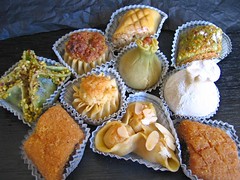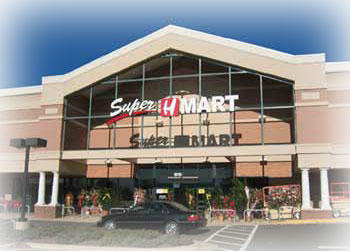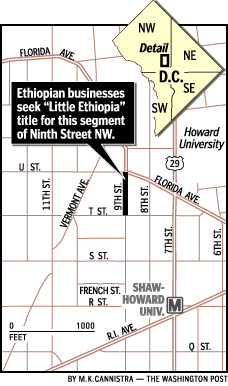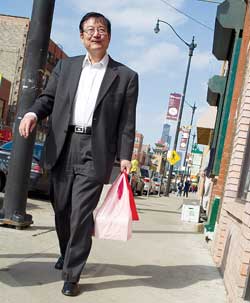Commerce dans de quartier de la ville, partie quatre (Commerz in the 'hood series)

La Bague de Kenza, Paris. Photo from the Station Gourmande blog.
Two weeks ago, the food section of the New York Times had an article about La Baque de Kenza, a pâtisserie orientale--Algerian bakery--in Paris. There are two paragraphs relevant to the recent discussion, although the use of the word "gentrified" might be a little incendiary in the context of the thread that erupted before and after the Post story earlier in the week, "Whose H Street Is It, Anyway? A Dispute Over Restaurant Zoning Creates a Chasm Between Northeast Washington's Old and New Residents."
From the NYT food section article (no longer available for free online, the article is "To Lure the French, Don't Be Too Sweet"):
L'Hassen Rahmani, one of the owners of Bague de Kenza, said that when he opened the shop 15 years ago, most of his customers were North Africans. Now he estimates that just 20% are North African, which mirrors the changing demographic of the 11th Arrondissement.
"When this neighborhood gentrified," said Jenny Lefcourt, an American living steps away from B.K., "instead of fleeing, many of the North African businesses stayed and went upscale so that they would appeal to the new neighborhood contingent. This has been happening all over the city."
The fundamental issue is the dynamism of city neighborhoods. The fact is that DC's retail sector isn't that dynamic in terms of quality independently-owned and operated businesses--because for the most part, new people seem to be needed on both the demand and the supply side, in order to stir things up.
While the city's real estate market has been relatively weak, the prices were relatively high considering the state of the average neighborhood commercial district, until the past few years. Most immigrants ended up in the suburbs.
Places like Langley Park in Maryland, and Annandale in Virginia are thriving centers of ethnic-oriented retail commerce. For example, today's Sunday has an article on Chinatown... in Montgomery County, Maryland! (MoCo's Chinatown). And Northern Virginia is known for a plethora of large, full-service ethnic supermarkets such as Super H Mart.

(Photo and text from Goldsea Asian American Parenting website.) Super H Mart, 10780 Lee Highway Fairfax, VA ... has caused so much stir since opening in November 2002 that Asians make up only about half the clientele.
Contrast this to a more typical center city, for example, Boston, where there is a Main Street program in Boston where the district is known for baking, where seven bakeries and restaurants serve Cape Verdean, Jamaican, Dominican, West Indian, Chinese, and classic American foods.
As I said earlier in the week in this thread, I think the issue is one of reaching out and capturing new market segments. Fearing change won't make change go away.
But DC hasn't been too welcoming frankly, as sentiments such as those expressed in this article, about Ethiopians "taking over Shaw," "Shaw Shuns 'Little Ethiopia'." Coincidentally, the author of this piece, Paul Schwartzman, also authored the piece on H Street... From the article:
"They haven't paid their dues," said Clyde Howard, 71, a retired postal worker and longtime Shaw activist. "Where were they during the [1968] riots? They're Johnny-come-lately. What gives them the right? Just because you opened a store?"...
Community leaders do not dispute that the Ethiopians are enterprising, but they said that few live in Shaw and that the new merchants have failed to forge ties with African American residents, sometimes coming across as aloof. "You get a gold star because you're good entrepreneurs, but that doesn't mean you get a whole corner," said Myla Moss, an Advisory Neighborhood Commission member whose district includes the east side of Ninth Street. "The timing is off. Until the glass wall evaporates and we can get a warmer vibe, I don't think you're going to have a lot of the African American community rallying around this."
 Washington Post graphic.
Washington Post graphic.Similarly, this article "In Shaw, Fighting Eviction, Change," about Cafe Mawonaj, also from the Post, is equally disconcerting... Again, the article is by Paul Schwartzman. From the article:
Myla Moss, an advisory neighborhood commissioner whose district includes the 600 block of T Street, said she would prefer to see an art gallery or a child-care center take over the property. The cafe, she said, seemed geared more toward students of Howard University than the neighborhood's residents.
Hmm, Myla Moss...
The great WestNorth blog from Chicago alerts us to the article "Chinatown’s staying power: A neighborhood grows, without losing its immigrant population," from the community newspaper Chicago Journal. As Payton says, "it turns out that Chinatown, er, Armour Square is a complete statistical anomaly—growing economically, attracting new investment, but without an increase in housing stress (e.g., rising rents or overcrowding). Much of this success stems from recycling capital within the community, through informal and formal financial networks, “a circuit of reinvestment that has maintained Chinatown’s vitality through decades when neighboring communities declined.” From the article:
Tourists flock to Chinatown in the thousands each year, but on any given afternoon on South Wentworth Avenue, they are visibly outnumbered by ethnic Chinese. In fact, Chinatown is one of the densest ethnic enclaves in Chicago, and also one of the most persistent. And Chinatown’s stability is attracting attention.
A recent study by Loyola University of gentrification in Chicago neighborhoods suggests that Chinatown’s vibrant retail district, and especially its success at drawing tourists and destination dollars, may have helped fortify the community against ethnic displacement. Yet restaurants and tourists alone do not stabilize neighborhoods. The Greek community left Greektown decades ago. Koreans whose businesses line West Lawrence Avenue, like many of the Indian business owners on Devon Avenue, tend to live in the suburbs, while the Vietnamese struggle to keep a toehold on Argyle Street....

Photo by Josh Hawkins, Chicago Journal. Garfield Ridge resident Juri Jones shops in Chinatown last week for an upcoming dance production.
"There’s the geographic isolation of the community," observes Payton Chung, a researcher for the Congress for New Urbanism. "But also the peculiar financial ties that bind it." Those ties have helped to keep generations of Chinese close. They have also, in effect, worked to keep non-Chinese out — though that may be starting to change.
The press release from the Loyola study, "Loyola University Chicago and City of Chicago Team Up in Latest Study: Impact of Gentrification on Chicago Communities is Probed," is worth a read. From the release:
Some of the key themes that emerged include:
Displacement in Relation to Race, Ethnicity and Social Class — In this study, it is clear that social class does underlie many of the differences and tensions seen in Chicago communities. Conflicts of "values" cited by respondents are often closely related to income differences or the social class differences between "old" and "new" residents. These issues, which often relate to a lack of understanding, communication and contact, have contributed to hostility, tension and conflict in many Chicago neighborhoods.
General Attitudes Toward Gentrification — There is not a dominant pro or con perspective on gentrification among the community leaders and residents interviewed for this study. Many noted that gentrification is having a primarily positive effect on their community. Residents enjoy seeing aesthetic improvements to homes and businesses opening up in the area. However, the uneasiness came when people had doubts about whether they could afford to stay in the community and benefit from the improvements.
Different Models of Gentrification Exist — To the residents of Humboldt Park and West Town, gentrification is generally seen by Latinos as middle- and upper-income "white anglos" moving into neighborhoods. These Anglo "yuppies" are viewed as isolated, racist, intolerant and even hostile towards the Puerto Rican and Latino people and cultures. However, to the residents of Douglas, Grand Boulevard, Kenwood and Oakland, social class issues have arisen in low-income African-American neighborhoods that are experiencing gentrification by middle-class African-American newcomers.
Labels: invasion-succession theory, retail, urban revitalization



0 Comments:
Post a Comment
<< Home